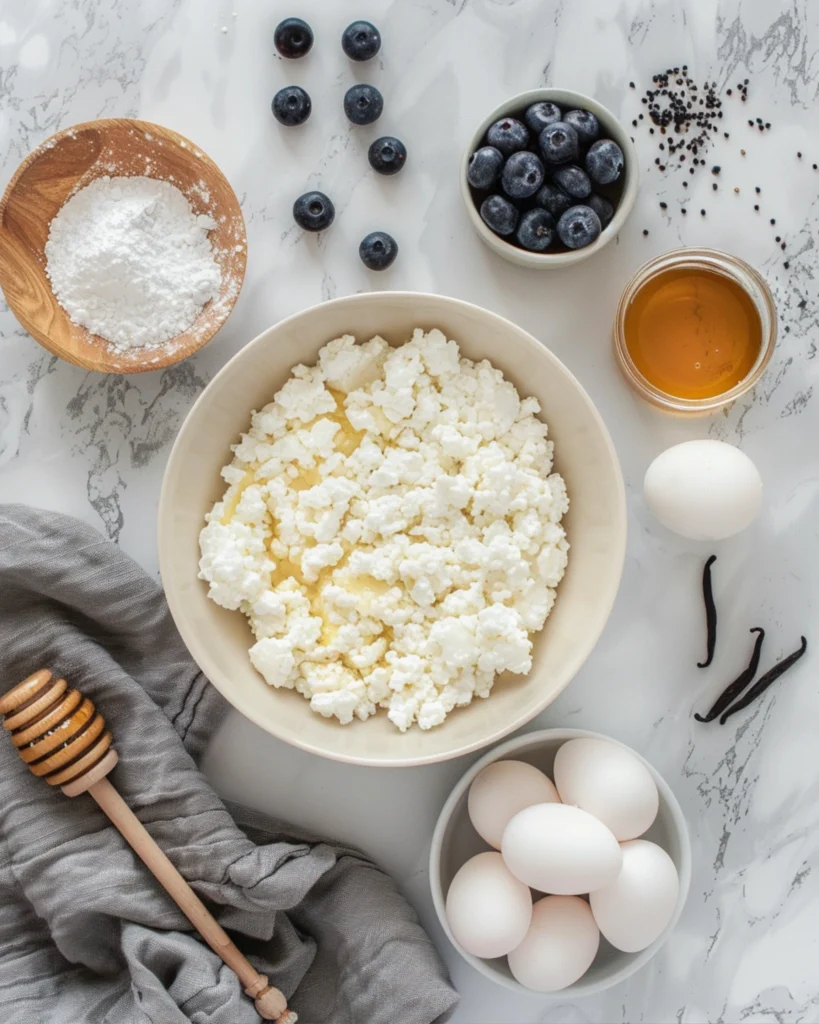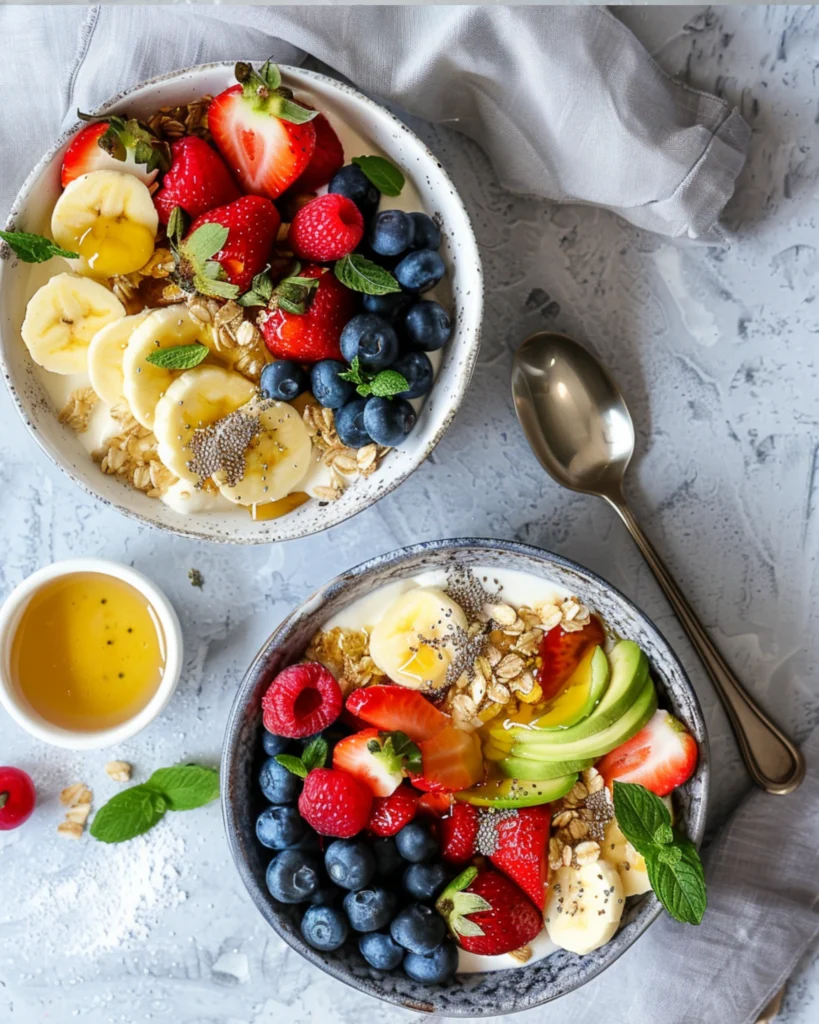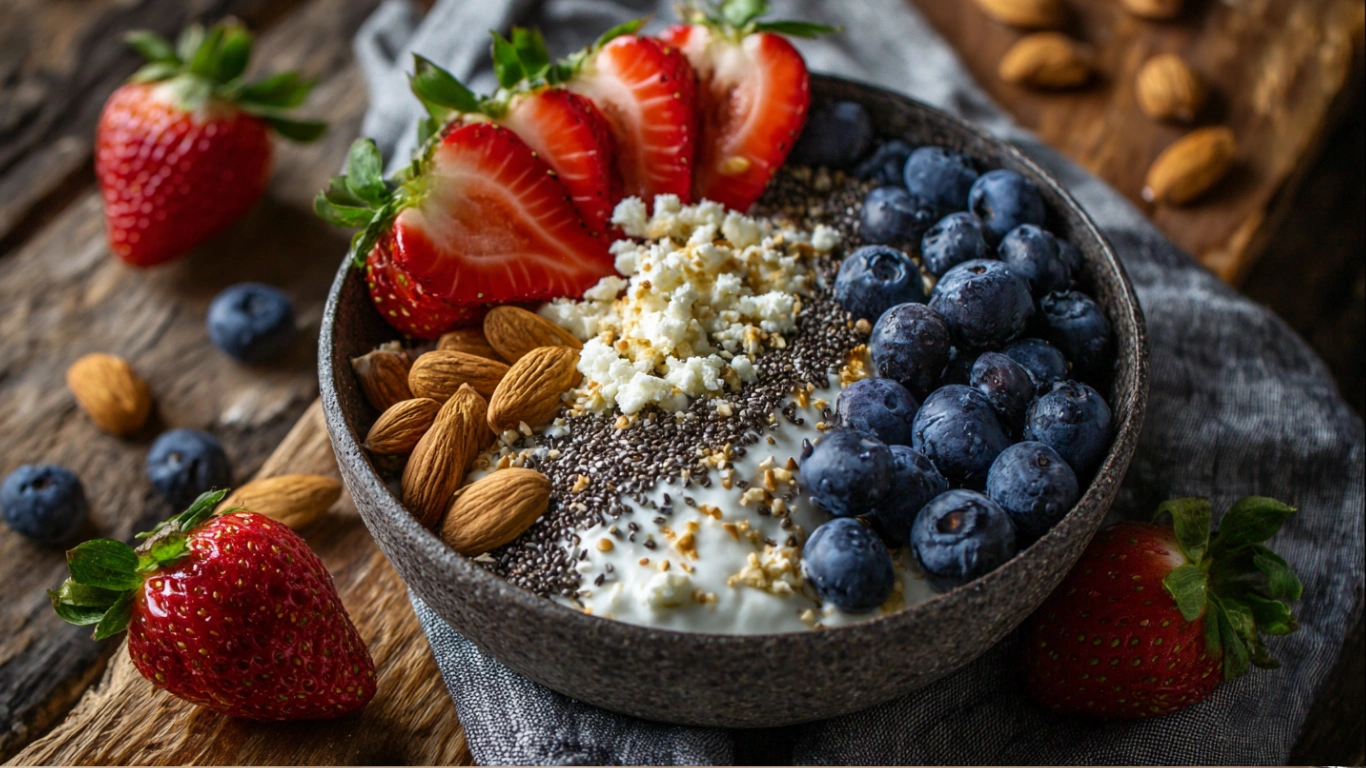When I first started paying attention to protein-rich meals, I kept looking for something quick, filling, and customizable. That’s when I discovered the cottage cheese protein power bowl—a simple dish that feels indulgent yet delivers serious nutrition.
One morning, I blended creamy cottage cheese with toppings like fresh fruit, nuts, and seeds. The result was a bowl that tasted as good as dessert but fueled me like a post-workout meal. It reminded me that healthy food doesn’t need to be complicated.
Since then, I’ve made countless versions—sweet with berries, savory with veggies and avocado, or even as a meal-prep option for busy days. It’s the kind of recipe that works for athletes, families, or anyone looking to eat better without sacrificing flavor.
Table of Contents
Why Choose a Cottage Cheese Protein Power Bowl?
Packed with protein for all-day energy
When it comes to quick, filling meals, few options match the power of a cottage cheese protein power bowl. Cottage cheese is a nutrition powerhouse—just one cup packs around 25 grams of protein, almost the same as eating a chicken breast. Protein is critical for satiety, meaning it keeps you fuller for longer, while also helping regulate blood sugar and repair muscles. This makes a cottage cheese bowl a smart choice for breakfast, lunch, or even dinner when you need something light but nourishing.
Unlike sugary cereals or pastries, which often leave you crashing mid-morning, this bowl provides sustained energy. The slow-digesting casein protein in cottage cheese is particularly beneficial, giving your body a steady stream of amino acids throughout the day. This makes it not only great for athletes but also for anyone who struggles with energy dips after meals.
Customizable to your lifestyle
One of the biggest benefits of a cottage cheese protein power bowl is how versatile it is. Prefer sweet flavors? Top it with fresh berries, banana slices, or a drizzle of honey. Craving something savory? Add roasted vegetables, avocado, or even smoked salmon for a more filling option.
This adaptability means you’ll never get bored. You can tailor your bowl to your dietary goals, whether that’s building muscle, losing weight, or simply eating more whole foods. Families love this meal because everyone can build their own version with favorite toppings.
For more balanced meals that pair comfort and nutrition, try our Protein Pancakes Recipe or Peanut Butter Coffee Smoothie.
Building the Perfect Cottage Cheese Protein Power Bowl
The protein-rich base
Every great cottage cheese protein power bowl begins with its base. Start with about one cup of cottage cheese, enough to deliver over 25 grams of protein while still leaving room for toppings. You can choose from several varieties depending on your dietary needs: full-fat for a creamy, indulgent base, low-fat for a lighter option, or lactose-free versions for sensitive stomachs. Whichever you choose, cottage cheese provides the satiety and nutrition that make this bowl stand out.
From there, you can keep things simple or build a more substantial meal. For athletes, adding grilled chicken, shredded turkey, or even smoked salmon turns the bowl into a post-workout powerhouse. Vegetarians can lean on black beans, lentils, or tofu for additional protein. The base is neutral enough that it pairs beautifully with both sweet and savory additions, making it endlessly adaptable.

The power of toppings
What makes a cottage cheese protein power bowl shine are the toppings. For a sweet version, pile on strawberries, blueberries, or banana slices for natural sugars and vitamins. Add a sprinkle of chia seeds, flaxseed, or almonds for crunch and extra nutrients. A drizzle of honey or maple syrup transforms it into something that tastes like dessert but still fuels your body.
On the savory side, think of Mediterranean flavors—cucumbers, cherry tomatoes, olives, and a drizzle of olive oil. Avocado adds healthy fats and creaminess, while a boiled egg or roasted veggies provide substance. Season with fresh herbs like parsley, cilantro, or dill for depth of flavor.
No matter which direction you choose, the toppings allow for endless creativity. Each bowl is a chance to meet your nutrient needs while enjoying a meal that’s colorful, flavorful, and satisfying.

Nutritional Benefits of Cottage Cheese
Protein, calcium, and essential nutrients
Cottage cheese is often called a “protein powerhouse,” and when used as the base for a cottage cheese protein power bowl, it transforms a simple dish into a nutrient-rich meal. One cup contains around 25 grams of protein—more than many traditional breakfast foods—making it ideal for anyone focusing on muscle maintenance or growth. But protein isn’t the only reason to love cottage cheese. It’s also packed with calcium for strong bones, B vitamins for energy metabolism, and phosphorus to support healthy cell function.
Depending on the type you choose, cottage cheese can also be relatively low in fat while still keeping you satisfied. Low-fat or 2% varieties provide a creamy texture without excess calories, while full-fat options can be more filling and indulgent. Either way, the nutrient profile makes it a smart base for balanced meals.

Why athletes and bodybuilders swear by it
Athletes and fitness enthusiasts often rely on cottage cheese because of its unique type of protein: casein. Unlike whey, which digests quickly, casein is digested slowly, releasing amino acids over several hours. This makes it particularly beneficial before bed, as it supports overnight muscle repair and recovery. Adding it into a cottage cheese protein power bowl ensures your body has sustained fuel throughout the day or night.
Another advantage is its versatility. By combining cottage cheese with toppings like fruit, vegetables, nuts, or lean protein, you create a meal that not only meets protein needs but also balances healthy fats and complex carbs. It’s no wonder bodybuilders, athletes, and health-conscious eaters make it a regular part of their diets.
For more energizing and protein-forward ideas, try our Cottage Cheese Crust Pizza or Apple Cinnamon Greek Yogurt Muffins.
Serving Ideas & Meal Prep Tips
Creative flavor combinations
The beauty of a cottage cheese protein power bowl is its adaptability. No matter your craving—sweet, savory, or somewhere in between—you can tailor the toppings to suit your taste and nutrition goals. For a sweet start to the day, pair cottage cheese with blueberries, strawberries, or pineapple. Add a drizzle of honey or maple syrup and a sprinkle of granola or chia seeds, and suddenly breakfast feels indulgent while still fueling your body.
Prefer something tropical? Combine cottage cheese with mango chunks, shredded coconut, and toasted almonds for a sunny, vacation-inspired bowl. For autumn vibes, try apple slices with cinnamon, walnuts, and a touch of nut butter. Each version is packed with flavor and offers a balance of protein, fiber, and healthy fats.
If savory is more your style, the options are just as exciting. Layer your cottage cheese with cherry tomatoes, cucumbers, avocado, and a drizzle of olive oil for a Mediterranean twist. Add smoked salmon, boiled eggs, or roasted chickpeas to turn it into a hearty, meal-worthy bowl. Herbs like parsley, cilantro, or dill add brightness without overpowering the dish.

Storing and meal-prep strategies
The cottage cheese protein power bowl also works beautifully for meal prep. While you’ll want to add toppings fresh to preserve textures, cottage cheese itself stores well in the refrigerator for up to five days. Prepare small containers of cottage cheese ahead of time, then portion out toppings like fruit, nuts, or veggies separately. When you’re ready to eat, just combine them—it takes less than five minutes.
For busy mornings, consider prepping “topping packs” in advance so you can mix and match flavors throughout the week. This not only saves time but also keeps meals exciting.

Cottage Cheese Protein Power Bowl
Ingredients
Equipment
Method
- Spoon cottage cheese into a bowl as the base.
- Add fruit or vegetables depending on sweet or savory preference.
- Sprinkle nuts and seeds on top for crunch and healthy fats.
- Drizzle with honey or olive oil for finishing flavor.
- Serve immediately or store components separately for meal prep.
Nutrition
Notes
From your stove to our hearts
share your delicious take!Is cottage cheese good for a protein diet?
Yes. Cottage cheese is an excellent protein source, offering around 25 grams per cup. It’s low in carbs, nutrient-dense, and versatile, making it ideal for high-protein diets, muscle building, and balanced weight-loss plans.
Are cottage cheese bowls healthy?
Absolutely. A cottage cheese protein power bowl combines protein, healthy fats, and fiber when paired with fruit, nuts, seeds, or vegetables. This balance makes it a filling, nutrient-rich choice for breakfast, lunch, or snacks.
Why do bodybuilders eat cottage cheese?
Absolutely. A cottage cheese protein power bowl combines protein, healthy fats, and fiber when paired with fruit, nuts, seeds, or vegetables. This balance makes it a filling, nutrient-rich choice for breakfast, lunch, or snacks.
How much protein does a bowl of cottage cheese have?
One cup of cottage cheese provides about 25 grams of protein. With toppings like nuts, seeds, or lean meats, a full bowl can easily reach 30–35 grams, making it a protein-packed meal for any diet.
Conclusion
The cottage cheese protein power bowl is more than a meal—it’s a flexible, high-protein choice that supports energy, recovery, and overall wellness. With a creamy cottage cheese base, endless topping options, and an impressive nutrient profile, it’s perfect for anyone seeking balance in their diet.
Whether you enjoy it as a sweet breakfast with fruit or a savory bowl with avocado and vegetables, it’s easy to prepare, customizable, and satisfying. A dish like this proves that eating healthy can be both delicious and convenient.
To learn more about the science behind cottage cheese and why it’s such a smart addition to your meals, explore this WebMD guide on cottage cheese nutrition. It explains how this simple food supports muscle growth, bone health, and weight management.
